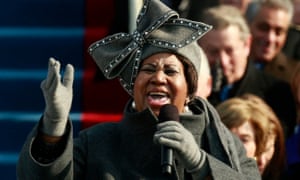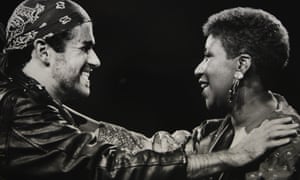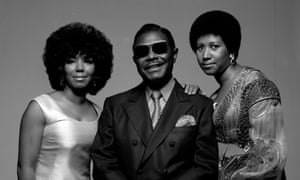Aretha Franklin obituary
Queen of soul whose voice could scald or soothe, and whose talent drew on both sacred and secular traditions
On a crisp, sparkling day in January 2009, Aretha Franklin stood on the steps of the Capitol in Washington, an ample figure swathed in a spectacular ensemble of coat and hat in two shades of grey, singing My Country, ’Tis of Thee to her new president. All around her, and down the full length of the National Mall, the vast audience included African Americans with tears in their eyes, celebrating the inauguration of Barack Obama. She was facing west, as hundreds of thousands of slaves had done when they landed on a bitter shore at the conclusion of their portage from Africa. “Let freedom ring,” she sang, in the anthem’s famous exhortation, and many millions watching on television around the world could not help but share the resonance of a historic moment.
Franklin, who has died aged 76, sounded exalted that day. She almost always did, even when handcuffed to unsympathetic material. Her voice could scald or soothe, singing with equal intimacy and intensity to her God or a faithless lover. She was both the heir to the sacred tradition of Mahalia Jackson and Clara Ward, frequent visitors to her childhood home, and the lineal descendant of the very secular Bessie Smith and Dinah Washington.
But it was that quality of exaltation that raised her above a remarkable generation of church-trained soul divas. Gladys Knight, Dionne Warwick,Candi Staton, Etta James, Mavis Staples, Tina Turner and many others were (and in some cases still are) great singers, but Aretha Franklin was the greatest of them all.
When, in 1967, she got hold of Otis Redding’s song Respect, originally a man’s urgent but politely phrased request for harmony in his home, she transformed it into a demand for equal rights on behalf of all women. A shout of impending triumph, challengingly direct in its unshackled power, it was also that summer’s hottest record in the discotheques, not least thanks to a supercharged interlude featuring the emphatic spelling-out of the song’s title, which she added to Redding’s original structure.
Known as the Queen of Soul, she was born into true American royalty as the daughter of one of the most celebrated of the nation’s black Baptist preachers, the Rev CL Franklin, and his wife, Barbara, a nurse’s aide and a singer and choirmistress in her husband’s church.
Clarence LaVaughn Franklin had met Barbara Siggers in Sunflower County, Mississippi, where he picked cotton while practising his preaching in small local churches. Aretha Louise – one of the couple’s four children, and named after her father’s two sisters – was born in Memphis, Tennessee, where CL Franklin had become pastor of the New Salem church; she was still an infant when they moved, first to Buffalo, New York State, and thence to Detroit, where her father became the minister of the New Bethel church. Aretha was six when her mother returned to Buffalo, accompanied by her son from a previous relationship. The remaining siblings were supervised in their father’s comfortable Detroit home by their paternal grandmother, Rachel, known as Big Mama, and a series of housekeepers, but spent the summers with their mother until Barbara died of a sudden heart attack when Aretha was 10.
The children – including an older sister, Erma, and a younger one, Carolyn, both gifted singers – grew up under the wing of a charismatic father who was among the first of his kind to spread his message via radio, recordings and national tours with his own travelling revival show. CL Franklin made friendships with many important African Americans: he marched alongsideMartin Luther King and ordained the young Jesse Jackson; Ward was an intimate friend; and Aretha once came home from school to find Art Tatum, the nonpareil jazz pianist, playing the family grand.
The preacher’s offspring grew up thoroughly steeped in the sung and spoken cadences of the gospel, in churches where smelling salts were always at hand to revive those overcome by spiritual possession. “Like my father,” Aretha wrote in her autobiography, From These Roots (1999), “the church always gave me a special kind of love.”
Rejecting formal keyboard lessons as a child, she learned to play by ear and mastered the techniques of gospel piano. She was also falling under the spell of rhythm and blues. Her friends and neighbours in Detroit included Berry Gordy Jr and Smokey Robinson, later to found the Motown label; another future Motown star, Marvin Gaye, dated her older sister. But it was a newly arrived music director at her father’s church, James Cleveland, who, although barely out of his teens himself, helped to focus her early career as a gospel singer.
She was 13 when she became pregnant and 14 when she gave birth to her first son, named Clarence, after her father – who did not chastise her, perhaps remembering that in 1940, during his marriage to Barbara, he had fathered a child with a 13-year-old member of his Memphis congregation. At 16 Aretha gave birth to another son, Edward; the identity of neither father was ever revealed.
Giving up formal education after the birth of her second child, she travelled extensively as a featured member of her father’s troupe. Her first album, recorded in churches across America, displayed the girl’s astonishing range, precocious control and blazing fervour. Seeing her potential, influential friends including Gordy and the singer Sam Cooke tried to lure her over to the secular side. In New York she recorded a demo tape that found its way to John Hammond, probably the pre-eminent talent scout of the century, whose proteges already numbered Smith, Count Basie, Benny Goodman andBillie Holiday (and would later include Bob Dylan and Bruce Springsteen).
Hammond, whose mother was a Vanderbilt, had dropped out of Yale to become an A&R man for Columbia Records. But although Franklin’s first release under his supervision was a song called Today I Sing the Blues, her early albums were dominated by familiar show songs and bland covers of recent pop hits. She could deliver them well enough but they were not her true medium, and her potential audience knew it.
It was during the Columbia years that her sister Erma introduced her to an attractive Detroit hustler named Ted White. “He was a take-charge kind of guy,” she remembered, “and before I knew it he had become my manager.” She could also see that he drank and womanised. Nevertheless they were married in 1961 while on the road “somewhere in Ohio”. Their son, Ted Jr, was born in 1964.
Her contemporaries were the emerging stars of soul music, but as long as she remained with Columbia she was trapped in the smart, superficial world of the supper club. “I felt it important to sing songs people knew and could sing along with,” she said, a misconception that was finally broken down when she linked up with Jerry Wexler, the vice-president of Atlantic Records, a former Billboard journalist who had already played an important role in the careers of Ray Charles, the Drifters and Solomon Burke. “You’ll do good things with Aretha,” his friend Hammond assured him. “You understand her musically.”
Wexler decided that in order to bring the best out of her, he had to get her out of New York and send her south, to a place where the roots of her artistry could emerge naturally.
In January 1967 Franklin and Wexler travelled down to Alabama for a scheduled two weeks of recording at the Fame studios in Muscle Shoals, where they were greeted by the studio’s owner, Rick Hall, and a rhythm section composed, in Wexler’s words, of “Alabama white boys who took a left turn at the blues”. Sensitive to the feelings of Franklin and her volatile husband in a potentially awkward environment, the producer had asked Hall to hire a horn section including black musicians. It was an instruction the studio owner ignored, with fateful consequences.
The first day’s session went well. Inspired by the singer’s delivery, the young musicians helped her to record a rolling, gospel-drenched version of a song called I Never Loved a Man (the Way I Love You), written by Ronnie Shannon, a Detroit songwriter who was a friend of White’s. As with many a relaxed recording session in the south, however, drink was being taken, and one member of the horn section began baiting White, in an exchange with racist overtones. That night, at the hotel where Franklin and her husband were staying, Hall arrived to apologise but, having been drinking himself, succeeded only in getting into a fist fight with White.
The singer and her husband flew back home the next morning, the Muscle Shoals project apparently aborted. Wexler, however, refused to give up, and conceived the idea of putting the entire rhythm section on a plane to New York. There, in mid-February, at Atlantic’s own Broadway studio, the team completed the session that would become Franklin’s first single and album for the label.
Rush-released as a 45 that same month, I Never Loved a Man created a sensation. Soul music was no longer a novelty, but here was deep soul at its most profound, using gospel cadences to trigger emotional tension and release.
There was no sense of politeness in Aretha’s portrayal of a sexual love both defiant and helpless, illustrating Wexler’s reflection, many years later, that “anguish surrounds Aretha as surely as the glory of her musical aura”. In the moment it hit the airwaves, Franklin assumed her rightful pre-eminence.
It sold 1m copies, but the next release was an even bigger hit. Joined by her sisters, she made Respect into a universal feminist anthem. Now there was no stopping her. She had found her voice, her style and her audience. In 1968 she became only the second African American to appear on the cover of Time magazine, with a story that celebrated her artistry but also hinted at violence within her marriage.
For the next seven years her recordings adhered to the same template of honesty and directness, featuring sympathetic material and first-rate musicians. The string of hits included A Natural Woman, Chain of Fools,Think (which would receive a further boost 11 years later when Franklin performed it in the film The Blues Brothers), and a glowing, timeless version of Burt Bacharach and Hal David’s I Say a Little Prayer.
There was a lull around 1969, the year in which she and White divorced, but she regained her momentum with Spanish Harlem, Rock Steady and Day Dreaming, and in 1971 she played at the Fillmore West in San Francisco, where the enthusiasm of a hippy audience was preserved on a live album. At the New Temple Missionary church in Los Angeles in 1972 she was reunited with the Rev James Cleveland, now a star in his own right, to make her first gospel record for a decade and a half, with her father and Ward among the congregation. Titled Amazing Grace, it sold more than 2m copies, making it the most successful gospel album of all time.
There were very few artistic missteps during this period, but in 1974, feeling the need to provide fresh stimulus, Wexler sent her to Los Angeles, whereQuincy Jones produced a patchy album whose highlight was Angel, a glistening song co-written by her sister Carolyn, eliciting one of her most compelling performances. Back with Wexler, she returned to the pop charts with Until You Come Back to Me, written by Stevie Wonder. Two years later a collaboration with Curtis Mayfield delivered the last of her Atlantic successes, Something He Can Feel, hitting No 1 in the R&B chart while only just scraping into the US pop Top 30, as if to prove that her original audience retained its loyalty. But the singer and the label parted company in 1979 after an overdressed disco-styled album, La Diva, made no impact. Wexler had left Atlantic and she was being courted by Clive Davis, the president of the Arista label, who soon added her to his roster.
After White had gone she spent several years in a relationship with her road manager, Ken Cunningham, with whom she had a son, Kecalf, in 1970. They separated in 1976 and she moved to Los Angeles, where she met an actor, Glynn Turman, to whom she was married in Detroit in 1978, in a ceremony presided over by her father.
A year later the Rev Franklin was shot in his home by a burglar and fell into a coma. He survived for a further five years without regaining consciousness, and in 1982 Aretha moved back to Detroit to help care for him. At his funeral in the New Bethel church, she observed, “the choir sang like they had never sung before”. She and Turman were divorced in 1984, although they remained friends.
Her relationship with Arista, which lasted 23 years, produced the hits Who’s Zoomin’ Who and Jump to It. There was a second gospel album, recorded at her father’s church, in which she sang with her sisters for the first time in many years, and there were duets with younger white artists such as Annie Lennox (Sisters Are Doin’ It For Themselves, 1985) and George Michael (I Knew You Were Waiting, a No 1 hit in 1987). She made her last recording, a “diva covers” album, in 2014, and announced her retirement from touring three years later.
Emulated by many but matched by none, she won 18 Grammys (and sang Puccini’s Nessun Dorma in place of an indisposed Luciano Pavarotti at the awards’ 40th anniversary ceremony), received honorary doctorates from Berklee College of Music and the universities of Detroit and Pennsylvania,sang at President Bill Clinton’s inauguration in 1993, and was awarded the US presidential medal of freedom by George W Bush.
A fighter for racial and gender justice, she walked off a Vogue photo session in the 60s when she noticed that all the other models were white. But she could seem vulnerable, and agoraphobia and a fear of flying were said to have prevented her from touring for long periods. A lover of food, extravagant gowns and adventurous hairstyles, she used her autobiography to attempt not just to catalogue seemingly every outfit she had worn on a big occasion but also to dispel, without great success, the prevailing impression that she possessed, as Hammond warned Wexler in 1967, a withdrawn and enigmatic character.
Her sister Carolyn died in 1988, followed by her brother Cecil the following year, and Erma in 2002. She is survived by her four sons. The bejewelled greyhat she wore to sing at Obama’s first inauguration is now in the Smithsonian Institution; her music is in the hearts of millions, on permanent loan.
• Aretha Louise Franklin, singer, pianist and songwriter, born 25 March 1942; died 16 August 2018








No comments:
Post a Comment